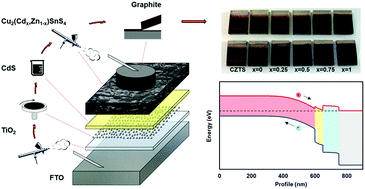Impact of cation substitution in all solution-processed Cu2(Cd, Zn)SnS4 superstrate solar cells†
Abstract
Thin-film solar cells constituted of abundant elements are key to ensuring mass production, reducing energy costs, and meeting energy demands. Kesterite is a cost-effective light absorber but to date has shown low compatibility with a superstrate architecture, and thus studied mostly with costly substrates. In the present study, we demonstrated that a cation substitution of Zn by Cd could improve the absorber compatibility on a superstrate architecture. Moreover, we employed all solution-processing using a water and ethanol mixture as green solvents for thin-film deposition. An increase in the Cd amount in the absorber layer led to improved crystallinity and a crystal-size increment, band gap decrement, and a change in the crystal structure from kesterite to cernyite. The composition of the buffer layer was controlled by the diffusion of Zn into CdS, forming (Cd, Zn)S with a relative Cd–Zn ratio. Solar cells prepared with high Cd showed a thicker depletion width and a reduction in the defect carrier density, leading to a significant increment in the power conversion efficiency of up to 1.9%. Furthermore, the fabricated solar cells showed high stability upon continuous light illumination of over 80 h. Investigation of the electrical losses in Cu2CdSnS4 suggested an ample opportunity to improve solar cell performance in a superstrate type architecture.



 Please wait while we load your content...
Please wait while we load your content...